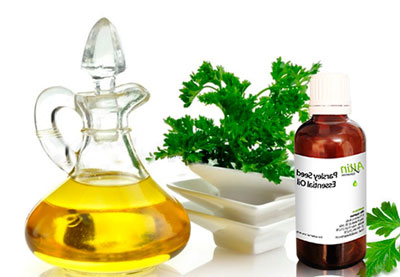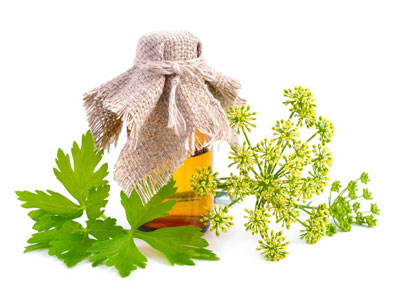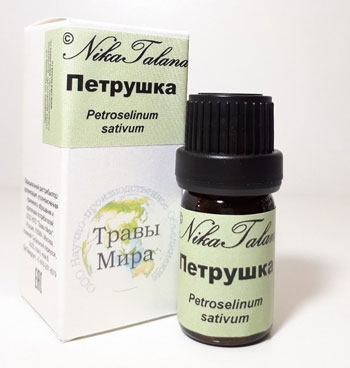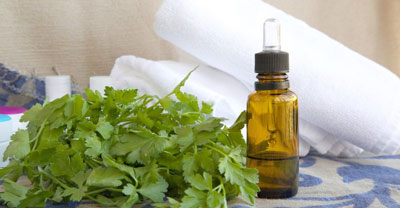
| HOME | MENU | DOCS | SEARCH |
Parsley is so firmly entrenched in cooking as a basic greenery, which has long been not perceived as a medicinal plant. But despite the stereotypical affiliation to spicy herbs, it is also a full-fledged healing culture with surprisingly many-sided properties, which are fully preserved in the oil extracted from its seeds. Parsley is one of the rare essential oils that show visible results from the very first uses. Soothing, whitening, eliminating edema, toning and effectively moisturizing, it can be used as a quick remedy to eliminate unpleasant symptoms.
Plant and production regions
Parsley essential oil is extracted from the very plant, without which no vegetable garden can be imagined. Along with dill, parsley is ranked among the most traditional and common spicy herbs.
Despite the Mediterranean origin of the plant, ether is predominantly produced in Holland, France, Hungary and Germany. As a country of origin (cultivation) of raw materials, the United States, Asian countries and Belgium are also allowed.

Marking oil and its varieties
It is impossible to get confused in the domestic names of oil, it is designated only as “parsley essential oil”, without any synonyms.
Foreign names: parsley seed essential oil (eng.), Huile essentielle de Persil (fr.), Petersilie ätherische öl (it.).
The marking must contain the Latin species name of the plant - Petroselinum crispum (parsley curly), while acceptable synonyms of Petroselinum sativum, Carum petroselinum are often found.
Parsley oil is divided into types depending on the raw materials used in the production: it can be extracted from the leaves along with the shoots (above-ground parts), from the shoots with rhizomes, very rarely - only from the roots. But still the most common type is ether, extracted only from seeds without the "green" parts of the plant.
All types of oil are very similar in their healing and cosmetic characteristics. The differences relate not only to color, aroma and minor nuances: each type has its own preferred methods of use and dosage. For example, for flavoring food use only the oil from the shoots and leaves.
When buying, it is necessary to clarify the information (or rather, make sure it is available) about the recommended dosages and methods of use for a particular ether. Check whether it is suitable for the tasks you are facing and that it has the characteristics you need.
Falsification
Parsley is so common and easy for plant cultivation that there is almost no sense in forging this oil. Moreover, in the production can be used as selected types of plant material, and extract oil from mixed aboveground and underground parts.
To purchase a quality product, it is enough to make sure that the manufacturer provides all the information about the raw materials, check the labeling, the method of obtaining and the availability of extremely clear instructions for use.

Receiving method and storage features
Regardless of which parts of the plant are used, essential oils are extracted using the standard method of simple one-step steam distillation. All other methods are unacceptable and may be considered as a method of falsification (including cold pressing and oil extraction).
In the composition of the oil to 85% of the volume should fall on myristicin. Also in the chemical formula are volatile fatty acids, apiol, terpenol, phellandrene and pinene.
This ester is beautifully stored at room temperature. If you comply with all the requirements of the manufacturer and when sealed packaging, it retains all its properties unchanged for at least 2 years.
External characteristics and features of the fragrance
All parsley oil is very fluid, light, perfectly distributed in the mixture, "invisible" on the skin, but rather annoying. Transparent esters from seeds may differ only slightly in consistency, they are always highlighted in a rich amber-brown or yellow tone. But the light-flowing oils from the aerial parts of the plant are much lighter, often with a noticeable greenish or yellow tint.
Smell is very changeable, everyone feels it in their own way. Characteristic of parsley overflows are caught only in the upper and very volatile notes and quickly disappear, giving way to an unexpected spicy-woody base, rich, terpkovato, with lower balsamic overtones.
The aroma cannot be “tied up” with the plant itself; it immediately conquers with a combination of grassiness, freshness, warmth, and a wood-complex base. The oil from the leaves is fresher and more grassy, sweet-sugary, from seeds it is more balsamic-woody, spicy.
Combination with other oils
Parsley oil is dominant and strong, its aroma is felt in any mixture, therefore, ethers with pure and close smells are chosen as complementary. Oakmoss, kananga, spicy oils (coriander and cinnamon), laurel, tea tree, rose, clary sage, neroli are perfect for perfume and cosmetic blends.
From the base is best combined with grape seed oil.

Impact on the psycho-emotional sphere
Parsley is characterized by an intense impact on psychological states. This is one of the best balancing emotions of oils, which allows you to achieve inner harmony, creates a sense of stability, soothes and gives confidence in their abilities.
Can be used for meditation. Eliminates physical and emotional manifestations of overwork, contributes to the effective treatment of problems and prevents stress and depressive disorders.
It is believed that the oil helps to sensibly assess their problems and feelings, to renounce extraneous influences and unnecessary experiences, hard thoughts. Giving a feeling of confidence, it allows you to restore inner peace of mind, find your own way and promotes deep relaxation.
It is an excellent tool for dealing with mental fatigue, helping to absorb new information and increase the productivity of intellectual work.
Healing properties
For the essential oil from both parsley seeds and leaves and shoots, antiseptic, bactericidal, healing, choleretic, diuretic, antispasmodic, anti-edematous, tonic effect is characteristic.
It is used to regulate the functioning of the bladder and kidneys, prevents the appearance of urolithiasis and cystitis. It is an effective diuretic that eliminates fluid retention and reduces puffiness.
Helps to eliminate various digestive disorders, is used to improve the work of the stomach and eliminate the symptoms of intoxication. Increases appetite.
Helps normalization of the menstrual cycle with scanty menstruation, can stimulate labor pains and enhance lactation. Prevents mastopathy.
Effectively with gout, rheumatism and arthritis due to its ability to improve blood circulation.
This is one of the "soft" wound-healing agents that prevents the formation of bruises and bruises with bruises and injuries.
Cosmetic properties
Parsley ether is considered to be one of the most powerful means to lighten skin and eliminate pigmentation. Eliminating freckles and other problems, it also helps to even out skin color, apparently improving its general condition, removing redness and dark spots, including around the eyes. The lightening and color-enhancing effects of parsley are several times more pronounced than those of citrus oils.
This oil is an excellent way to enrich daily homemade cosmetics, because it has the ability to actively improve the overall condition of the skin. It improves the processes of moisturizing, restores skin tone, helps to restore its softness and velvety.
It is one of the main oils for the care of mature, dehydrated, sensitive, oily and problem skin (due to antiseptic properties) and one of the best remedies for the skin around the eyes.
Parsley is suitable for medical cosmetics and products for the treatment of dry seborrhea, to relieve eyelid swelling, to combat pigment spots and acne.
Due to the ability of the oil to constrict blood vessels, it is used for resorption of hematomas and their prophylaxis, for the treatment of capillary drawings (in this case, for visible results, a long course of procedures is required). Cleans the blood, stimulates blood flow and can be used to clean wounds.
When used for cosmetic purposes, it should be borne in mind that this oil prevents sunburn and brightens the skin.
Parsley oil is also used for hair care. It has an active moisturizing and toning effect on the scalp, helps restore hair strength and beauty.

Use in the domestic sphere
Oils obtained from parsley leaves and sprouts can be used as food for flavoring ready meals.
Seed oils will be a bright woody component of homemade perfumes and soaps, and they also demonstrate excellent deodorizing properties.
Features of use and precautionary measures
Regardless of the type of plant material used, parsley ethers belong to quite intense and toxic. They act aggressively and strongly, therefore they are always used in reduced dosages and not exceeding the recommended course duration of 2-3 weeks. For sensitive skin, it is desirable to reduce the dosage by half.
Negative reactions and parsley intolerance are rare.
This oil can not be used during pregnancy, because it can provoke a contraction of the uterus. It should refrain from its use and with heavy, painful menstruation.
It is not recommended to take inside with a stomach ulcer or duodenal ulcer, as well as in the presence of chronic and inflammatory diseases of the kidneys and bladder.
When excessive concentration causes dizziness. It is not used in aroma baths, hot inhalations, aroma lamps.
Methods of use and dosage
Parsley is used only in a few classical methods of aromatherapy in the following dosages:
• for improvement of cosmetics or preparation of house cosmetics add 1 drop on 10 mg of a basis;
• to create medicinal cosmetics - 1-3 drops per 10 ml of base;
• to improve homemade hair care products in the amount of 1-2 drops per one portion of shampoo or balm;
• for aroma massage and rubbing - 5-7 drops per 30 ml of base;
• for cold inhalations in procedures lasting no more than 3-4 minutes;
• for internal administration in the amount of 1-2 drops per tablespoon of base oil, additionally mixing with any thick and sweet emulsifier, washing down with plenty of water, up to 2-3 times a day (it is better to start the procedure with 1 drop of ether);
• as a flavoring beverage and food - 1-2 drops.
See Parsley

When creating this article was used material
from the following sources.
To the list of oilseeds of plant origin
We recommend that you look at the popular sections of the site myvaleology.com: MENU with a description of the sections | |||
| SOCIAL | DONATION | MY DIET | MY SPORT |
|
|
Release all4e8 |
||
Copyright © VZOJ 2023. All rights reserved. When reprinting or quoting myvaleology.com materials please put a link to the site myvaleology.com :
<a href="https://myvaleology.com">Healthy lifestyle</a>